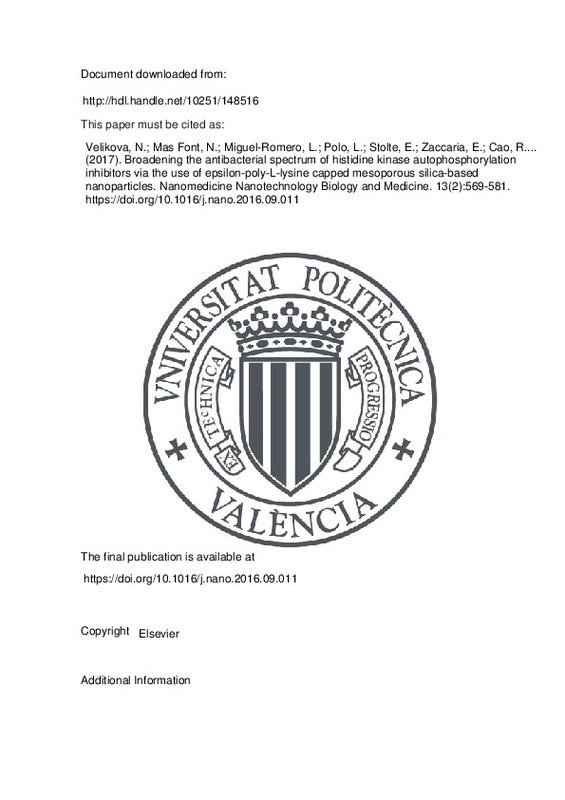JavaScript is disabled for your browser. Some features of this site may not work without it.
Buscar en RiuNet
Listar
Mi cuenta
Estadísticas
Ayuda RiuNet
Admin. UPV
Broadening the antibacterial spectrum of histidine kinase autophosphorylation inhibitors via the use of epsilon-poly-L-lysine capped mesoporous silica-based nanoparticles
Mostrar el registro sencillo del ítem
Ficheros en el ítem
| dc.contributor.author | Velikova, Nadya
|
es_ES |
| dc.contributor.author | Mas Font, Nuria
|
es_ES |
| dc.contributor.author | MIguel-Romero, Laura
|
es_ES |
| dc.contributor.author | Polo, Lorena
|
es_ES |
| dc.contributor.author | Stolte, Ellen
|
es_ES |
| dc.contributor.author | Zaccaria, Edoardo
|
es_ES |
| dc.contributor.author | Cao, Rui
|
es_ES |
| dc.contributor.author | Taverne, Nico
|
es_ES |
| dc.contributor.author | Murguía, Jose R.
|
es_ES |
| dc.contributor.author | Martínez-Máñez, Ramón
|
es_ES |
| dc.contributor.author | Marina, Alberto
|
es_ES |
| dc.contributor.author | Wells, Jerry
|
es_ES |
| dc.date.accessioned | 2020-07-23T03:31:04Z | |
| dc.date.available | 2020-07-23T03:31:04Z | |
| dc.date.issued | 2017-02 | es_ES |
| dc.identifier.issn | 1549-9634 | es_ES |
| dc.identifier.uri | http://hdl.handle.net/10251/148516 | |
| dc.description.abstract | [EN] Two-component systems (TCS) regulate diverse processes such as virulence, stress responses, metabolism and antibiotic resistance in bacteria but are absent in humans, making them promising targets for novel antibacterials. By incorporating recently described TCS histidine kinase autophosphorylation inhibitors (HKAIs) into epsilon-poly-L-lysine capped nanoparticles (NPs) we could overcome the Gram negative (Gr(-)) permeability barrier for the HKAIs. The observed bactericidal activity against Gr(-) bacteria was shown to be due to the enhanced delivery and internalization of the HKAIs and not an inhibitory or synergistic effect of the NPs. The NPs had no adverse effects on mammalian cell viability or the immune function of macrophages in vitro and showed no signs of toxicity to zebrafish larvae in vivo. These results show that HKAIs are promising antibacterials for both Gr(-) and Gr + pathogens and that NPs are a safe drug delivery technology that can enhance the selectivity and efficacy of HKAIs against bacteria. (C) 2016 Elsevier Inc. All rights reserved. | es_ES |
| dc.description.sponsorship | This work was funded by FP7 ITN STARS-Scientific Training in Antimicrobial Research Strategies (Contract No. PITN-GA-2009-238490, J.M.W., A.M.), H2020 MSCA IF (AND-659121, N.V.), grant BIO2013-42619-P from the Ministerio de Economia y Competitividad (A.M.), grant from the Spanish Government (Project MAT2015-64139-C4-1-R,N. M., J.R.M, R.M.M.), and a grant from Generalitat Valenciana (Project PROMETEOII/2014/047, N.M.). and Prometeo II/2014/029, A.M.). | es_ES |
| dc.language | Inglés | es_ES |
| dc.publisher | Elsevier | es_ES |
| dc.relation.ispartof | Nanomedicine Nanotechnology Biology and Medicine | es_ES |
| dc.rights | Reconocimiento - No comercial - Sin obra derivada (by-nc-nd) | es_ES |
| dc.subject | Multi-drug resistance | es_ES |
| dc.subject | Gram negative | es_ES |
| dc.subject | Nanotechnology | es_ES |
| dc.subject | Drug delivery | es_ES |
| dc.subject | Two-component systems | es_ES |
| dc.subject.classification | PROYECTOS DE INGENIERIA | es_ES |
| dc.subject.classification | QUIMICA INORGANICA | es_ES |
| dc.subject.classification | BIOQUIMICA Y BIOLOGIA MOLECULAR | es_ES |
| dc.subject.classification | QUIMICA ANALITICA | es_ES |
| dc.title | Broadening the antibacterial spectrum of histidine kinase autophosphorylation inhibitors via the use of epsilon-poly-L-lysine capped mesoporous silica-based nanoparticles | es_ES |
| dc.type | Artículo | es_ES |
| dc.identifier.doi | 10.1016/j.nano.2016.09.011 | es_ES |
| dc.relation.projectID | info:eu-repo/grantAgreement/EC/FP7/238490/EU/Scientific Training in Antimicrobial Research Strategies/ | es_ES |
| dc.relation.projectID | info:eu-repo/grantAgreement/MINECO//MAT2015-64139-C4-1-R/ES/NANOMATERIALES INTELIGENTES, SONDAS Y DISPOSITIVOS PARA EL DESARROLLO INTEGRADO DE NUEVAS HERRAMIENTAS APLICADAS AL CAMPO BIOMEDICO/ | es_ES |
| dc.relation.projectID | info:eu-repo/grantAgreement/EC/H2020/659121/EU/Antibacterial (Nano)medicines Development/ | es_ES |
| dc.relation.projectID | info:eu-repo/grantAgreement/MINECO//BIO2013-42619-P/ES/ESTRUCTURA, FUNCION, RECONOCIMIENTO Y EVOLUCION EN SEÑALIZACION CELULAR: DE LO BACTERIANO (SISTEMAS DE DOS COMPONENTES) A LO UNIVERSAL (DUTPASAS)/ | es_ES |
| dc.relation.projectID | info:eu-repo/grantAgreement/GVA//PROMETEOII%2F2014%2F029/ES/Genes, proteínas y rutas de señalización en enfermedades raras/ | es_ES |
| dc.relation.projectID | info:eu-repo/grantAgreement/GVA//PROMETEOII%2F2014%2F047/ES/Nuevas aproximaciones para el diseño de materiales de liberación controlada y la detección de compuestos peligrosos/ | es_ES |
| dc.rights.accessRights | Abierto | es_ES |
| dc.contributor.affiliation | Universitat Politècnica de València. Departamento de Biotecnología - Departament de Biotecnologia | es_ES |
| dc.contributor.affiliation | Universitat Politècnica de València. Departamento de Química - Departament de Química | es_ES |
| dc.contributor.affiliation | Universitat Politècnica de València. Departamento de Proyectos de Ingeniería - Departament de Projectes d'Enginyeria | es_ES |
| dc.description.bibliographicCitation | Velikova, N.; Mas Font, N.; Miguel-Romero, L.; Polo, L.; Stolte, E.; Zaccaria, E.; Cao, R.... (2017). Broadening the antibacterial spectrum of histidine kinase autophosphorylation inhibitors via the use of epsilon-poly-L-lysine capped mesoporous silica-based nanoparticles. Nanomedicine Nanotechnology Biology and Medicine. 13(2):569-581. https://doi.org/10.1016/j.nano.2016.09.011 | es_ES |
| dc.description.accrualMethod | S | es_ES |
| dc.relation.publisherversion | https://doi.org/10.1016/j.nano.2016.09.011 | es_ES |
| dc.description.upvformatpinicio | 569 | es_ES |
| dc.description.upvformatpfin | 581 | es_ES |
| dc.type.version | info:eu-repo/semantics/publishedVersion | es_ES |
| dc.description.volume | 13 | es_ES |
| dc.description.issue | 2 | es_ES |
| dc.identifier.pmid | 27720925 | es_ES |
| dc.relation.pasarela | S\350447 | es_ES |
| dc.contributor.funder | Generalitat Valenciana | es_ES |
| dc.contributor.funder | Ministerio de Economía y Competitividad | es_ES |







![[Cerrado]](/themes/UPV/images/candado.png)

